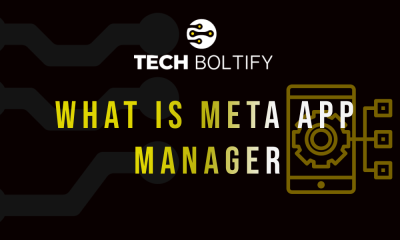Tech
What is Emotional AI and How is It Shaping the Future of Consumer Experiences
Science fiction said it first: Artificial Intelligence might be able to understand our emotions.
Though most of us thought it was something out of a movie, the reality isn’t that far off.
Emotional AI is now a real possibility for the near future.
Simply put, your devices could understand what you’re feeling: your phone, your car, or your smart assistant could be able to tell if you’re stressed, frustrated, or happy and respond accordingly.
Emotional AI is revolutionizing consumer experiences by humanizing many interactions. But how does it work, and why does it matter?
Let’s explore how emotional AI is changing things and how many industries are already adapting to this emerging trend.
Getting to understand emotional AI
Though many people know it as emotional AI, the technical name is “affective computing,” and it refers to technology that detects and responds to human emotions. It’s a complex combination of artificial intelligence, machine learning, and behavioral analytics, and it can interpret facial expressions, voice tone, text sentiment, and even physiological signals in your body.
It is as impressive as it sounds because although AI has created a shockwave in most industries, emotional AI can go even further by understanding us better.
How does emotional AI work?
There are several clues and techniques artificial intelligence has access to analyze human emotions, and these include:
- Facial recognition: this is nothing new, facial recognition has been in use for years, but AI can use it to understand your facial expression and detect emotions such as anger, tiredness or happiness.
- Voice analysis: AI can interpret your speech patterns, pitch, and tone to understand how you’re feeling.
- Biometric sensors: although we’ve had wearable devices for years, these could have embedded AI and detect physiological responses to your emotions.
These methods help brands and businesses create personalized, emotionally intelligent interactions with consumers.
Emotional AI is transforming consumer experiences: here’s how
Companies that are using emotional AI in their services aim to improve customer engagement and user experiences and drive more sales.
- Better customer support
Chatbots are part of our reality, but sometimes, they can be frustrating to use, especially in contexts like healthcare. Emotional AI can detect frustration and change its answers accordingly. The idea is to have empathetic, kind interactions and solve problems faster.
- Smart marketing and ads
With emotional AI, brands can get to know how their consumers react to their ads, and tailor their content after detecting trends in their target audience. People could have engaging and relevant ads, with messages that resonate with them.
- Better shopping experiences online
Retailers can use emotional AI to understand their customers’ mood, providing personalized recommendations. From smart mirrors to AI powered shoppings assistants, the possibilities are endless.
Ethical concerns, privacy issues, and AI
Although the market for AI is predicted to grow beyond 1.8 trillion U.S. dollars by 2030, we can’t dismiss ethical concerns.
Emotional AI has many benefits for companies, but where do we draw the line? Are there regulations for data privacy, security, and the potential misuse of this technology?
How is emotional data collected and stored?
Emotional AI systems gather tons of personal data to work properly. From facial recognition to voice recordings and biometric signals, most of what makes us emotional can be recorded and stored in a server somewhere.
That’s where most people start asking questions about their consent and data protection.
Security risks and emotional AI
Consumers are becoming more aware of how their privacy works in the digital world. Many people might wonder, for example, what is VPN on an iPhone?
That’s because they wish to protect their online activity and personal information properly. As emotional AI grows, users have to understand how their data is being used, and they should have the choice to remain anonymous online.
Bias in AI and other risks
There is bias in AI because the AI is only as good as the data we feed it. If AI models are trained on non-diverse datasets and limited in the information they have, there’s ample ground to misinterpret emotions.
Companies currently developing emotional AI have to consider their users’ privacy and test their models extensively before launching them onto the market.
Final thoughts
Technology moves forward, and emotional AI will continue shaping the way businesses and companies of all sizes interact with their consumers.
Innovation is possible, but it has to be balanced with ethical responsibility and respect for people’s right to privacy.
While the possibilities are exciting, the future of emotional AI will depend on responsible development, clear regulations, and a focus on consumer trust, or people might opt out.
If done right, this technology has the power to create deeper, more meaningful connections between people and the digital world.
Tech
The Complete Guide to AI Comment Classification: Spam, Slander, Objections & Buyers
Meta ad comment sections are unpredictable environments. They attract a mix of users—some legitimate, some harmful, some automated, and some simply confused. For years, brands relied on manual review or simple keyword filters, but modern comment ecosystems require more advanced systems.
Enter AI comment classification.
AI classification engines evaluate language patterns, sentiment, intention, and user context. They categorize comments instantly so brands can prioritize what matters and protect what’s most important: trust, clarity, and conversion.
The Four Major Comment Types
1. Spam & Bots
These include cryptocurrency scams, fake giveaways, bot‑generated comments, and low‑value promotional content. Spam misleads users and diminishes ad quality. AI detects suspicious phrasing, repetitive patterns, and known spam signatures.
2. Toxicity & Slander
These comments contain profanity, hostility, misinformation, or attempts to damage your brand. Left unmoderated, they erode trust and push warm buyers away. AI identifies sentiment, aggression, and unsafe topics with high accuracy.
3. Buyer Questions & Objections
These represent your highest-value engagement. Users ask about pricing, delivery, sizing, guarantees, features, or compatibility. Fast response times dramatically increase conversion likelihood. AI ensures instant clarification.
4. Warm Leads Ready to Convert
Some comments come from buyers expressing clear intent—“I want this,” “How do I order?”, or “Where do I sign up?” AI recognizes purchase language and moves these users to the top of the priority stack.
Why AI Is Necessary Today
Keyword lists fail because modern users express intent in creative, informal, or misspelled ways. AI models understand context and adapt to evolving language trends. They learn patterns of deception, sentiment clues, emotional cues, and buyer intent signals.
AI classification reduces the burden on marketing teams and ensures consistent and scalable comment management.
How Classification Improves Paid Media Performance
• Clean threads improve brand perception
• Toxicity removal increases user trust
• Fast responses increase activation rate
• Meta rewards high-quality engagement
• Sales teams receive properly filtered leads
For brands spending heavily on paid social, classification isn’t optional—it’s foundational.
Tech
How To Bridge Front-End Design And Backend Functionality With Smarter API Strategy
Introduction: Building More Than Just Screens
We’ve all seen apps that look sharp but crumble the moment users push beyond the basics. A flawless interface without strong connections underneath is like a bridge built for looks but not for weight. That’s why APIs sit at the heart of modern software. They don’t just move data; they set the rules for how design and logic cooperate. When APIs are clear, tested, and secure, the front-end feels smooth, and the backend stays reliable.
The reality is that designing those connections isn’t just “coding.” It’s product thinking. Developers have to consider user flows, performance, and future scale. It’s about more than endpoints; it’s about creating a system that’s flexible yet stable. That mindset also means knowing when to bring in a full-stack team that already has the tools, patterns, and experience to move fast without cutting corners.
Here’s where you should check Uruit’s website. By focusing on robust API strategy and integration, teams gain the edge to deliver features user’s trust. In this article, we’ll unpack how to think like a product engineer, why APIs are the real bridge between design and functionality, and when it makes sense to call in expert support for secure, scalable development.
How To Define An API Strategy That Supports Product Goals
You need an API plan tied to what the product must do. Start with user journeys and map data needs. Keep endpoints small and predictable. Use versioning from day one so changes don’t break clients. Document behavior clearly and keep examples short. Design for errors — clients will expect consistent messages and codes. Build simple contracts that both front-end and backend teams agree on. Run small integration tests that mimic real flows, not just happy paths. Automate tests and include them in CI. Keep latency in mind; slow APIs kill UX. Think about security early: auth, rate limits, and input checks. Monitor the API in production and set alerts for key failures. Iterate the API based on real use, not guesses. Keep backward compatibility where possible. Make the API easy to mock for front-end developers. Celebrate small wins when a new endpoint behaves as promised.
- Map user journeys to API endpoints.
- Use semantic versioning for breaking changes.
- Provide simple, copy-paste examples for developers.
- Automate integration tests in CI.
- Monitor response times and error rates.
What To Do When Front-End and Backend Teams Don’t Speak the Same Language
It happens. Designers think in pixels, engineers think in data. Your job is to make a shared language. Start by writing small API contracts in plain text. Run a short workshop to align on fields, types, and error handling. Give front-end teams mocked endpoints to work against while the backend is built. Use contract tests to ensure the real API matches the mock. Keep communication frequent and focused — short syncs beat long meetings. Share acceptance criteria for features in user-story form. Track integration issues in a single list so nothing gets lost. If you find repeated mismatches, freeze the contract and iterate carefully. Teach both teams basic testing so they can verify work quickly. Keep the feedback loop tight and friendly; blame only the problem, not people.
- Create plain-language API contracts.
- Provide mocked endpoints for front-end use.
- Contract tests between teams.
- Hold short, recurring integration syncs.
- Keep a single backlog for integration bugs.
Why You Should Think Like a Product Engineer, Not Just A Coder
Thinking like a product engineer changes priorities. You care about outcomes: conversion, help clicks, retention. That shifts API choices — you favor reliability and clear errors over fancy features. You design endpoints for real flows, not theoretical ones. You measure impact: did a change reduce load time or drop errors? You plan rollouts that let you test with a small cohort first. You treat security, observability, and recoverability as product features. You ask hard questions: what happens if this service fails? How will the UI show partial data? You choose trade-offs that help users, not just satisfy a design spec. That mindset also tells you when to hire outside help: when speed, scale, or compliance exceeds your team’s current reach. A partner can bring patterns, reusable components, and a proven process to get you shipping faster with less risk.
- Prioritize outcomes over features.
- Measure the user impact of API changes.
- Treat observability and recovery as product features.
- Plan gradual rollouts and feature flags.
- Know when to add external expertise.
How We Help and What to Do Next
We stand with teams that want fewer surprises and faster launches. We help define API strategy, write clear contracts, and build secure, testable endpoints that front-end teams can rely on. We also mentor teams to run their own contract tests and monitoring. If you want a quick start, map one critical user flow, and we’ll help you design the API contract for it. If you prefer to scale, we can join as an extended team and help ship several flows in parallel. We stick to plain language, measurable goals, and steady progress.
- Pick one key user flow to stabilize first.
- Create a minimal API contract and mock it.
- Add contract tests and CI guards.
- Monitor once live and iterate weekly.
- Consider partnering for larger-scale or compliance needs.
Ready To Move Forward?
We’re ready to work with you to make design and engineering speak the same language. Let’s focus on one flow, make it reliable, and then expand. You’ll get fewer regressions, faster sprints, and happier users. If you want to reduce risk and ship with confidence, reach out, and we’ll map the first steps together.
Tech
Which SEO Services Are Actually Worth Outsourcing? Let’s Talk Real-World Wins
Okay, raise your hand if you thought SEO just meant stuffing keywords into blog posts and calling it a day. (Don’t worry, we’ve all been there.) Running a business comes with enough hats already, and when it comes to digital stuff, there’s only so much you can do on your own before your brain starts melting. The world of SEO moves quick, gets technical fast, and—honestly—a lot of it’s best left to the pros. Not everything, but definitely more than people expect. So, let’s go through a few of those SEO services you might want to hand off if you’re looking to get found by the right folks, minus the headaches.
Technical SEO—More Than Just Fancy Talk
If you’ve ever seen a message saying your website’s “not secure” or it takes ages to load, yeah, that’s technical SEO waving a big red flag. This stuff lives under the hood: page speed, mobile-friendliness, fixing broken links, and getting those little schema markup things in place so search engines understand what the heck your pages are about.
You could spend hours (days) learning this on YouTube or DIY blogs, but hiring a specialist—someone who does this all day—saves you a load of stress and guesswork. Sites like Search Engine Journal dig into why outsourcing makes sense, and honestly, after one too many late-night plugin disasters, I’m convinced.
Content Writing and On-Page Optimization (Because Words Matter)
Let’s not dance around it: great content still rules. But search-friendly content is a different beast. It needs to hit the right length, work in keywords naturally, answer genuine questions, and actually keep visitors hooked. Outsourcing writing, especially to someone who actually cares about your brand’s tone, is worth it for most of us.
On-page SEO, which is tweaking all those little details like titles, descriptions, internal links, and image alt text, is a time-eater. It’s simple once you get the hang of it, but when you’re trying to grow, outsourcing makes the most sense.
Link Building—Trickier Than It Looks
Here’s where things get a bit spicy. Backlinks are essential, but earning good ones (not spammy or shady stuff) takes relationship-building, tons of outreach, and real patience. You can spend all month sending emails hoping someone will give your guide a shout-out, or you can just hire folks with connections and a process. Just watch out for anyone promising “hundreds of links for dirt cheap”—that’s usually a shortcut to trouble.
Local SEO—Getting Seen in Your Own Backyard
Ever tried showing up for “pizza near me” only to find yourself on page 7? Local SEO isn’t magic, but it takes a special touch: optimizing your Google Business Profile, gathering reviews, and making sure your info matches everywhere. It’s honestly a job in itself, and most small teams find it way easier to have a local SEO pro jump in a few hours a month.
Reporting and Analytics—Don’t Go Blind
Last, don’t skip out on real reporting. If nobody’s tracking what’s working—and what’s not—you’re just flying blind. Outsourced SEO pros come armed with tools and real insights, so you can see if your money’s going somewhere or just swirling down the drain.
Wrapping Up—Be Realistic, Outsource Smarter
You’re good at what you do, but SEO is more like ten jobs rolled into one. Outsource the parts that zap your time or make your brain itch, and keep what you enjoy. Focus on the wins (more leads, higher rankings, fewer headaches), and watch your business get the attention it deserves.
-
Tech1 year ago
AI and Freight Management
-

 Tech2 years ago
Tech2 years agoLPPe Service Android App and its Functions – How to Remove it
-

 Tech1 year ago
Tech1 year agoWhat is a Permission Controller – Control Manager Notifications
-

 Tech2 years ago
Tech2 years agoWhat is Device Keystring App On Android
-

 Tech2 years ago
Tech2 years agoWhat is Carrier Hub – How to Resolve Processing Requests Issues
-

 Tech2 years ago
Tech2 years agoWhat is Summit IMS Service – How to Stop Syncing on Your Android Device
-

 Tech2 years ago
Tech2 years agoMeta App Manager – What is Meta App Installer
-

 Tech2 years ago
Tech2 years agoWhat is Cameralyzer Samsung – How to Fix or Uninstall Cameralyzer on Android

